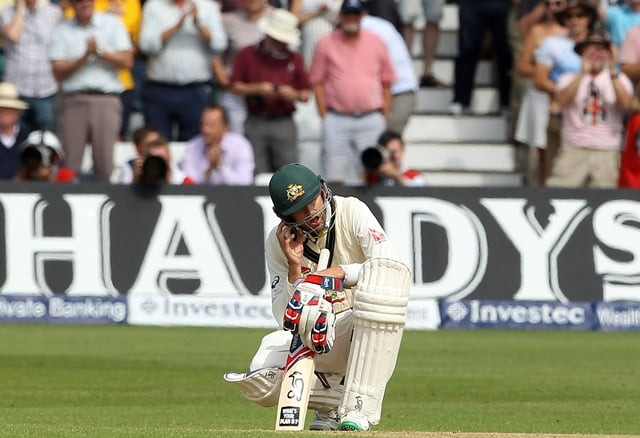Fancy a pinch-hitter in whites?
An incredible influx of T20 cricket has brought around a discernible change in the approach of teams even in Tests

Australia's Nathan Lyon reacts after losing his wicket to England's Mark Wood. PHOTO: AFP
Stuart Broad unleashed a spell of fury on the opening day. The Australians fielding batsmen like David Warner, Chris Rogers, Steve Smith, Clarke and Adam Voges, who look a million-dollar on flat decks around the world, were all at sea at a track where the ball was hopping around corners.
In a matter of 37 balls, the pack was together in the dressing room with a combined tally of 17 runs, the silence between them must have been deathly— surely there is more noise in a morgue.
In recent years, the incredible influx of Twenty20 cricket has brought around a discernible change in the approach of teams even in the longest format. The Australians for instance score at a rate of more than four runs to the over— when they actually score.
 PHOTO: AFP
PHOTO: AFPBut other than upping the scoring rate, teams from around the world have generally tried to combat testing pitches and atmospheric conditions through the conventional manner of grinding their way out.
Despite a packed support staff, including analysts and coaches, no team has attempted an out of the box approach like sending in a pinch-hitter out in the middle.
In the Trent Bridge Test, Australia were three down inside eight overs, with the ball swerving all over the place, the chances of survival for a batsmen were as good as non-existent. Even the players with solid techniques (Chris Rogers, Steve Smith) found it impossible to deal with the seam and swing of the English bowlers.
Darren Lehmann— the Aussie coach and Clarke must have felt numb as the catastrophic collapse unfolded. Now consider this, if Australians would have somehow held their wits and experimented with a change in the batting order.
Mitchell Johnson, a useful lower-order batsman with the ability of hitting the ball long and hard, could have been promoted in the order.
 PHOTO: AFP
PHOTO: AFPOf course his chances of survival would have been lesser than that of the frontline batsmen, but here is the trick, what if he would have been sent in with a license to attack from the outset? At 10 for three, Australia were desperate for every run. Johnson could have hit an ugly, scratchy 30-40 by flashing his blade hard outside the off-stump.
Some of his edges or miss-hits could have soared over the slips, the inside edges could have sneaked past the stumps down the fine-leg fence, or with the kind of luck the Kangaroos were enduring he could have even been dismissed first ball, of course we would never know, since the attempt of bucking the trend of one batsman following the other was never made!
No team, in recent memory at least, has tried to reverse the batting order either. While this might sound ludicrous to many but the merits and demerits of an invention are never known till the invention is tested. Similarly, consider the exciting proposition that a reverse batting order offers. Let’s refocus on the Trent Bridge Australian debacle, or let’s go a game earlier.
In the Edgbaston Test, Australia were rolled over for 136 in the first innings. After the Lords exploits on a placid track, the batsmen had their techniques torn apart by the boomerang swing of James Anderson.
The tourists never recovered and even at Trent Bridge stayed mired in their conventional approach— the 60-all-out rout though was perhaps inevitable.
If the bowlers would have been sent ahead of the batsmen, they might have galloped to 100 for five by lunch, the conditions would have eased considerably in the second session, and the five ‘proper’ batsmen might still have had the chance of propelling the score.
The ‘experts’ continue to bemoan the technical frailties of the batsmen. Former Test players, who themselves caved in against the moving ball, are adamant that the only way to counter the movement is through a stoic defence.
 PHOTO: AFP
PHOTO: AFPBut they seem to ignore the fact that any bowler worth his salt would make it impossible for the batsmen to survive through a dour, defensive technique, especially when the run flow is choked.
Flailing at the ball at least helps gather some runs which can tilt the game and not to forget makes a bowler lose his line and length.
In the last five years, the Aussies (four) and their Pakistani counterparts (six) are the two teams that have been embarrassed for an under 100 total more than any other team. After the Australian are done with the humiliation, Pakistan brace for a tour of England next year.
The infamous 2010 skirmish— better remembered for the damning spot-fixing scandal— saw the tourist disintegrate for sub-100 totals no less than three times.
England are bound to produce seaming tracks for the Asian visitors. The question now poised for an answer is whether the technically frail Pakistan batsmen can counter the conditions any better than the Australians or will the duo of Waqar Younis and batting coach Grant Flower attempt to pull a rabbit out of the hat?



















COMMENTS
Comments are moderated and generally will be posted if they are on-topic and not abusive.
For more information, please see our Comments FAQ